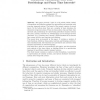Free Online Productivity Tools
i2Speak
i2Symbol
i2OCR
iTex2Img
iWeb2Print
iWeb2Shot
i2Type
iPdf2Split
iPdf2Merge
i2Bopomofo
i2Arabic
i2Style
i2Image
i2PDF
iLatex2Rtf
Sci2ools
PPSWR
2004
Springer
2004
Springer
Calendrical Calculations with Time Partitionings and Fuzzy Time Intervals
This paper presents a piece in a big mosaic which consists of formalisms and software packages for representing and reasoning with everyday temporal notions. The kernel of the mosaic consists of several layers. At the bottom layer there are a number of basic datatypes for elementary temporal notions. These are time points, crisp and fuzzy time intervals and partitionings for representing periodical temporal notions like years, months, semesters etc. Partitionings can be arranged to form ‘durations’ (e.g. ‘2 semester and 1 month’). Each formalism in the bottom layer comes with its own functions and relations. The second layer is presented in this paper. It contains a number of basic functions which use time points, intervals, partitionings and durations simultaneously. The functions are introduced and motivated with temporal expressions in natural language. The third layer, which is not presented in this paper, uses the functions and relations of the lower layers as building blo...
| Added | 02 Jul 2010 |
| Updated | 02 Jul 2010 |
| Type | Conference |
| Year | 2004 |
| Where | PPSWR |
| Authors | Hans Jürgen Ohlbach |
Comments (0)

